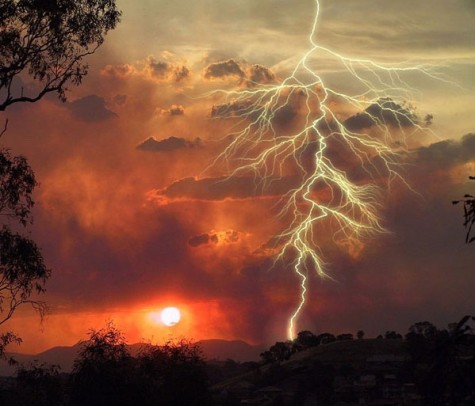 Last weekend there was an unseasonal lightning storm on the coast. Not here (thank goodness, for our dog’s sake), but farther south. More than 1,400 strikes touched down across the region, with 13 people reporting injuries in Los Angeles County alone. A golfer was hit on Catalina Island, 22 miles from Los Angeles. One young man died after being struck in the water in Venice Beach.
Last weekend there was an unseasonal lightning storm on the coast. Not here (thank goodness, for our dog’s sake), but farther south. More than 1,400 strikes touched down across the region, with 13 people reporting injuries in Los Angeles County alone. A golfer was hit on Catalina Island, 22 miles from Los Angeles. One young man died after being struck in the water in Venice Beach.
Some people thought the boom of thunder was an earthquake. You see, people don’t usually think of lightning at the beach in the summer around here.
Inland, sure: a study looking at lightning flashes in Southern California found the mountains and the high deserts draw extensive summertime lightning, particularly in the afternoon and early evening, at the peak of the day’s heat. Over coastal waters lightning is more common in the winter, before dawn, coming in with a cold winter storm.
Uncommon doesn’t mean impossible. You just need the right ingredients, the right conditions, good timing: the thunderstorm as the equivalent of the chocolate soufflé. Instead of beaten egg yolks and egg whites and someone ready at the table to eat at the height of its poufy glory, you need air that’s moist and unstable, and something to get it moving upward.
The inland topography here seems to make lightning converge on certain places: mountains, the high desert. There are summertime monsoons in the mountains, sometimes bringing the rain that we could have used months ago. The peaks of the San Gabriel and the east-west Santa Ynez, of the San Rafael and of the Sierra Madre poke above the stable marine inversion layer that hugs the coast and draw air upward to kick off storms. In summer, these storms move in from the south and southeast, from Mexico and the Gulf of Mexico, and don’t have enough power to reach the valleys and coasts on the far side.
Last weekend a high-pressure system coaxed very wet, warm air up from Mexico and the Gulf of California, sending a series of storm cells along the coast that didn’t seem to see the mountains as a barrier. The situation hardly ever happens: a NASA expert called Southern California “virtually lightning proof,” and said that the odds of being struck by lightning in the state were one in 7.5 million.
Still, nine years ago today we got back from our honeymoon to learn that a good friend of my husband’s—we’d seen him six weeks before at our wedding—had been hit by lightning. So had a boy on the Sierra backpacking trip Steve had been leading. On the way to the funerals, we pulled across several double-yellow lines to get to a gas station and got out to find a police officer behind us.
The officer gave us a warning. “See those two sets of lines?” he asked. “Think of them like a brick wall.”
They were a wall, those bright lines running through the darkened asphalt of the sky. But there wasn’t a way to explain all that. We just nodded and watched him until he drove away.
**
Image by Scotto Bear from North Beach, MD, USA via Wikimedia Commons